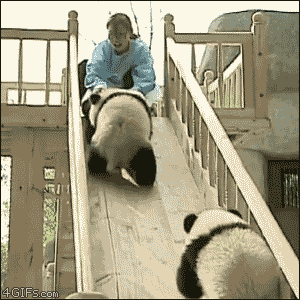You are using an out of date browser. It may not display this or other websites correctly.
You should upgrade or use an alternative browser.
You should upgrade or use an alternative browser.
Auto Pilot Usage
- Thread starter CLTflyer
- Start date
poser765
Well-Known Member
Pandas are dicks.*panda gif*
it's ok, though...they are like the only species that is actively bringing about their own extinction.
TwoTwoLeft
o- - - - - - -l
I really had no idea this was almost as emotional a topic as pitch for airspeed and power for rate of descent.
So what are you trying to say? The power levers DON'T control my airspeed with the AP on????

:stir:
PeanuckleCRJ
Poodle Wrangler
So what are you trying to say? The power levers DON'T control my airspeed with the AP on????
:stir:

Ah, the internet searches that study breaks result in.
TwoTwoLeft
o- - - - - - -l

Payback....
My bad. Are we not supposed to use real panda?
PeanuckleCRJ
Poodle Wrangler

My bad. Are we not supposed to use real panda?
That so perfectly illustrates how this thread went.
gotWXdagain
Polished Member
Tommay85
Well-Known Member
Pandas wish they were catsSo what are you trying to say? The power levers DON'T control my airspeed with the AP on????
:stir:
ASpilot2be
Qbicle seat warmer
Our CTOT system sets whatever torque setting you have dialed in on takeoff. The Captain pushes the power levers up to about 80%, then the FO engages the CTOT and the power automatically sets to 100%(or whatever you have dialed in.)Are you talking about the "needle bug thingies" on the torque gauge that are disabled? The HMU does auto enrich for a constant torque climb. T6 is an issue though...
Tommay85
Well-Known Member
Interesting. Must be nice...Our CTOT system sets whatever torque setting you have dialed in on takeoff. The Captain pushes the power levers up to about 80%, then the FO engages the CTOT and the power automatically sets to 100%(or whatever you have dialed in.)
Hacker15e
Who am I? Where are my pants?
Actually, I would consider that a secondary reason. The primary reason is to do what a machine can't do: make decisions. The autopilot can't look ahead and see those build-ups that warrant deviation, for example. An autopilot can't hear a guy on the radio report a 30 knot loss on final and decide to wait out the departure a little while. Pilots make these kinds of decisions everyday, while something "goes wrong" incredibly rarely.
While I agree with this point, there's a reason I said it the way I did and did not include decisionmaking in the mix.
I'll call it "the UAV/RPA effect". As millions of military hours operating UAVs/RPAs have shown, it is possible to have this human decisionmaking in the loop of aircraft operations but without actually having them in the cockpit of the aircraft. Every single one of the circumstances you mention, and the others, can all be done with a guy sitting in a box thousands of miles away, listening to the same radios, looking outside via a couple of cameras, and in some cases with access to situational-awareness building materials via the internet that an in-the-cockpit pilot doesn't have access to.
But remote piloting -- which still very much allows that decisionmaking you reference -- again cannot handle either avionics failures (especially those that impact the sensors needed to "see/hear", and parts of the control link) or catastrophic emergencies/failures.
So, again, we are ultimately left with the man-in-the-cockpit as that last actual line of defense in saving the ship and pax in the event of something actually going wrong...and thus the core actual purpose of him being there.
Polar742
All the responsibility none of the authority
This means hand-flying to stay proficient at the "zero" automation level.
You'd be hard pressed to find me argue against this. However, from your other posts, what you think automation (the kind that gets pilots jammed up) is not what you think it is.
Flying up to the teens is not some yeager-esque ego-trip. That's laughable. If you're climbing out at 1,500fpm (which is slow for a super duper jet powered spaceship) and you're only hand-flying to transition, you're only looking at 12 minutes of hand flying. 12 freaking minutes. On a 3-hour flight, if you fly for 12 minutes during departure, and 12 minutes during landing you're only hand-flying for about 7% of your flight.
Again, because you fly in a high-cycle operation, you have no idea the challenges segments of the pilot population face. The idea that we operate in an enviroment like the US where one has a choice as to how to fly the airplane doesn't exist.
I'll also add that in my limited experience it's substantially easier to stay sharp on automation usage and mode selection than it is to stay sharp on hand flying the airplane as well. Additionally, in everyairplane I've flown, I could hand-fly with the FD engaged and have the same modes show up on the score-board (with the exception of AP).
This illustrates perfectly what I'm talking about. Operating a non-integrated mode FD with an autopilot isn't in the same ballpark as a fully integrated avionics suite. Not using the FMC in our airplane is akin to flying around without charts in a steam airplane. Takeoff and landing speeds? In the FMC. Tuning ground based navs? In the FMC. Any chance of navigating a go-around? Gotta keep the FMC working or you generate task saturation as soon as the maneuver is begun.
What the rest of us are referring to is managing a fully integrated mode (250' AGL through an autoland) using various integrated modes and non-integrated modes while coordinating changes in the FMC.
If you think that isn't near as demanding as flying a circling NDB in the soup being knocked around at night OEI with no flaps (yes, some of us have taken those check rides too), you haven't flown the types of airplanes we have. And stuff that is elbows up in non-integrated airplanes is really low-workload or an easy adjustment in one of these planes. Things that are very basic in steam airplanes take our cockpits from 0-100 in 2 seconds. There's a reason 2 pilots with decades of experience and thousands of hours in type take their full concentration.
Just like anything else, once you learn to conduct the orchestra, it's not hard. But there are very different workload management and aircraft management techniques involved, including stuff you do now, have done in the past, and things you haven't experienced yet.
amorris311
Well-Known Member
How far up do the power levers have to be before the system can engage? Also I heard the ctot works wonders if you have to trend monitor your engines in cruise.Our CTOT system sets whatever torque setting you have dialed in on takeoff. The Captain pushes the power levers up to about 80%, then the FO engages the CTOT and the power automatically sets to 100%(or whatever you have dialed in.)
When I used to fly the Space Shuttles, I usually hand flew up to 250,000ft then kicked on the autopilot. In the descent, I usually kicked it off just before re-entry and glided it in
You didn't do the HI-NDB approach into Kennedy Space Center using circling minima?
Screaming_Emu
Well-Known Member
You'd be hard pressed to find me argue against this. However, from your other posts, what you think automation (the kind that gets pilots jammed up) is not what you think it is.
Again, because you fly in a high-cycle operation, you have no idea the challenges segments of the pilot population face. The idea that we operate in an enviroment like the US where one has a choice as to how to fly the airplane doesn't exist.
This illustrates perfectly what I'm talking about. Operating a non-integrated mode FD with an autopilot isn't in the same ballpark as a fully integrated avionics suite. Not using the FMC in our airplane is akin to flying around without charts in a steam airplane. Takeoff and landing speeds? In the FMC. Tuning ground based navs? In the FMC. Any chance of navigating a go-around? Gotta keep the FMC working or you generate task saturation as soon as the maneuver is begun.
What the rest of us are referring to is managing a fully integrated mode (250' AGL through an autoland) using various integrated modes and non-integrated modes while coordinating changes in the FMC.
If you think that isn't near as demanding as flying a circling NDB in the soup being knocked around at night OEI with no flaps (yes, some of us have taken those check rides too), you haven't flown the types of airplanes we have. And stuff that is elbows up in non-integrated airplanes is really low-workload or an easy adjustment in one of these planes. Things that are very basic in steam airplanes take our cockpits from 0-100 in 2 seconds. There's a reason 2 pilots with decades of experience and thousands of hours in type take their full concentration.
Just like anything else, once you learn to conduct the orchestra, it's not hard. But there are very different workload management and aircraft management techniques involved, including stuff you do now, have done in the past, and things you haven't experienced yet.
*drops mic*
ASpilot2be
Qbicle seat warmer
The power levers have to be past the 64 degree switch. That is good to know about trend monitoring.How far up do the power levers have to be before the system can engage? Also I heard the ctot works wonders if you have to trend monitor your engines in cruise.
dasleben
That's just, like, your opinion, man
Todd, with those numbers, you're exactly the guy who should be hand-flying as much as possible.I've flown so little this past two years that I've had to go back to the sim for landing currency twice, and I've been real close a few other times. I'm at about 70 hours of block time for this entire year, so even if I did all of this silly hand flying, my number would be pretty low.

